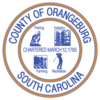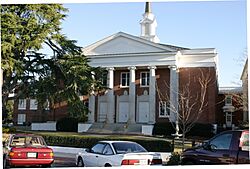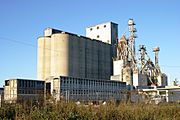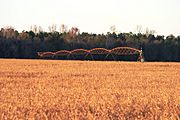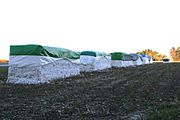Orangeburg County, South Carolina facts for kids
Quick facts for kids
Orangeburg County
|
|||
|---|---|---|---|

Old Orangeburg County Jail
|
|||
|
|||
| Motto(s):
"Community & Character"
|
|||

Location within the U.S. state of South Carolina
|
|||
 South Carolina's location within the U.S. |
|||
| Country | |||
| State | |||
| Founded | March 12, 1785 | ||
| Named for | William of Orange | ||
| Seat | Orangeburg | ||
| Largest community | Orangeburg | ||
| Area | |||
| • Total | 1,127.89 sq mi (2,921.2 km2) | ||
| • Land | 1,106.38 sq mi (2,865.5 km2) | ||
| • Water | 21.51 sq mi (55.7 km2) 1.91% | ||
| Population
(2020)
|
|||
| • Total | 84,223 | ||
| • Estimate
(2023)
|
82,820 | ||
| • Density | 76.12/sq mi (29.39/km2) | ||
| Time zone | UTC−5 (Eastern) | ||
| • Summer (DST) | UTC−4 (EDT) | ||
| Congressional districts | 2nd, 6th | ||
Orangeburg County is a county located in the U.S. state of South Carolina. As of the 2020 census, the population was 84,223. Its county seat is Orangeburg. The county was created in 1769.
Orangeburg County comprises the Orangeburg, South Carolina Micropolitan Statistical Area, which is also included in the Columbia-Sumter-Orangeburg, South Carolina Combined Statistical Area. It is located in the Midlands of South Carolina.
It is the home of South Carolina State University, the only public four-year historically Black university in South Carolina. It is also home to Claflin University, the oldest historically Black college or university (HBCU) in the state.
Contents
History
The district was occupied for thousands of years by Indigenous peoples of the Southeastern Woodlands. By the time of European arrival, Eastern Siouan-speaking tribes, such as the Cheraw, Catawba, and Pedee, inhabited the Piedmont area above the fall line.
The Orangeburg Judicial District was chartered by European Americans in 1769 from a mostly unorganized upland area between the Congaree and Savannah rivers. A county, initially of the same name but later called Orange, was organized within the district but deorganized in 1791, after the American Revolutionary War.
The southwest portion bordering on the Savannah River, about half of Orangeburg District, was separated and organized as Barnwell District in 1800. In 1804 the northern third of the district was separated to form the new Lexington District, which gained another, smaller portion of Orangeburg District in 1832.
During the 19th century, the districts and counties were developed chiefly as cotton plantations for short-staple cotton. This development followed the invention of the cotton gin in the late 18th century, which made the processing of short-staple cotton profitable. The county became a center of labor by enslaved Black people on the plantations, who were transported from coastal areas and the Upper South to cultivate and process cotton. Those brought from the coastal areas were likely of the Gullah culture and language. The enslaved African Americans greatly outnumbered the white planters and non-slaveholding whites. Reflecting the patterns of 19th-century settlement, the area is still chiefly agricultural and has a majority African American population.
In 1868, under the revised state constitution during the Reconstruction era, South Carolina districts were organized as counties. Resident voters were enabled to elect their state representatives rather than having them chosen by the state legislature, as was done previously. Election of representatives by the state legislature had kept the districts dominated by the elite owners of major plantations in the Low Country and elsewhere. The changes in rules expanded participation in the franchise by more male residents. Emancipation of slaves after the war under newly ratified federal constitutional amendments resulted in freedmen voting. Using voter intimidation, white Democrats took control of the state legislature by the end of the century; they passed state electoral laws and a new constitution that essentially disfranchised most blacks, a situation that lasted until after the federal legislation of the 1965 Voting Rights Act.
A small western portion of Orangeburg County was annexed in 1871 to the newly formed Aiken County during the Reconstruction era.
In 1908 the northern portion of the County along the Congaree River was separated and included in the newly formed Calhoun County, with its seat at Saint Matthews. In 1910 a small western portion of Berkeley County, around Holly Hill and Eutawville, was annexed to Orangeburg County, thus bringing the county to its present size.
Geography
According to the U.S. Census Bureau, the county has a total area of 1,127.89 square miles (2,921.2 km2), of which 1,106.38 square miles (2,865.5 km2) is land and 21.51 square miles (55.7 km2) (1.91%) is water. It is the second-largest county in South Carolina by land area and fifth-largest by land area.
Orangeburg county is a fairly big county, covering 1,128 square miles, it is about 60 miles from the western part of the county to the eastern part of the county. Orangeburg county lies within 3 "regions" of South Carolina. The western part of the county lies in the "CSRA" (Central Savannah River Area). The middle part of Orangeburg county is included in the "Midlands" Region. The eastern and south eastern part of the county are located in the "Lowcountry" region of the state.
National protected areas
State and local protected areas
- Santee Cooper Wildlife Management Area
- Indian Bluff Recreation Park
- Santee State Park
Major water bodies
- Congaree River
- Cooper River
- Edisto River
- Four Hole Swamp
- Lake Marion
- North Fork Edisto River
- South Fork Edisto River
Adjacent counties
- Calhoun County – north
- Clarendon County – northeast
- Dorchester County – southeast
- Berkeley County – southeast
- Bamberg County – south
- Colleton County – south
- Aiken County – west
- Barnwell County – west
- Lexington County – northwest
Demographics
| Historical population | |||
|---|---|---|---|
| Census | Pop. | %± | |
| 1790 | 18,513 | — | |
| 1800 | 15,766 | −14.8% | |
| 1810 | 13,229 | −16.1% | |
| 1820 | 15,653 | 18.3% | |
| 1830 | 18,453 | 17.9% | |
| 1840 | 18,519 | 0.4% | |
| 1850 | 23,582 | 27.3% | |
| 1860 | 24,896 | 5.6% | |
| 1870 | 16,865 | −32.3% | |
| 1880 | 41,395 | 145.4% | |
| 1890 | 49,393 | 19.3% | |
| 1900 | 59,663 | 20.8% | |
| 1910 | 55,893 | −6.3% | |
| 1920 | 64,907 | 16.1% | |
| 1930 | 63,864 | −1.6% | |
| 1940 | 63,707 | −0.2% | |
| 1950 | 68,726 | 7.9% | |
| 1960 | 68,559 | −0.2% | |
| 1970 | 69,789 | 1.8% | |
| 1980 | 82,276 | 17.9% | |
| 1990 | 84,803 | 3.1% | |
| 2000 | 91,582 | 8.0% | |
| 2010 | 92,501 | 1.0% | |
| 2020 | 84,223 | −8.9% | |
| 2023 (est.) | 82,820 | −10.5% | |
| U.S. Decennial Census 1790–1960 1900–1990 1990–2000 2010 2020 |
|||
2020 census
| Race | Num. | Perc. |
|---|---|---|
| White (non-Hispanic) | 27,787 | 32.99% |
| Black or African American (non-Hispanic) | 50,802 | 60.32% |
| Native American | 467 | 0.55% |
| Asian | 892 | 1.06% |
| Pacific Islander | 37 | 0.04% |
| Other/Mixed | 2,271 | 2.7% |
| Hispanic or Latino | 1,967 | 2.34% |
As of the 2020 census, there were 84,223 people, 32,129 households, and 20,620 families residing in the county.
2010 census
At the 2010 census, there were 92,501 people, 35,788 households, and 23,580 families in the county. The population density was 83.6 inhabitants per square mile (32.3 inhabitants/km2). There were 42,504 housing units at an average density of 38.4 units per square mile (14.8 units/km2). The racial makeup of the county was 62.2% black or African American, 34.3% white, 0.8% Asian, 0.5% American Indian, 0.9% from other races, and 1.2% from two or more races. Those of Hispanic or Latino origin made up 1.9% of the population. In terms of ancestry, 7.7% were American, and 5.1% were German.
Of the 35,788 households, 32.5% had children under the age of 18 living with them, 38.1% were married couples living together, 22.5% had a female householder with no husband present, 34.1% were non-families, and 29.0% of households were made up of individuals. The average household size was 2.49 and the average family size was 3.06. The median age was 38.1 years.
The median household income was $32,849 and the median family income was $40,332. Males had a median income of $35,934 versus $28,508 for females. The per capita income for the county was $17,579. About 21.1% of families and 25.8% of the population were below the poverty line, including 32.9% of those under age 18 and 19.1% of those age 65 or over.
Economy
Orangeburg County is one of the largest agricultural producing counties in South Carolina, with fertile, slightly rolling land. Major crops are cotton, soybeans, corn, turf grass and watermelons.
In 2022, the GDP was $3.4 billion (about $40,510 per capita), and the real GDP was $2.8 billion (about $33,219 per capita) in chained 2017 dollars.
As of April 2024[update], some of the largest employers in the county include Claflin University, GPM Investments, Husqvarna Group, Love's, Medical University of South Carolina, Orangeburg–Calhoun Technical College, South Carolina State University, Okonite, and Walmart.
| Industry | Employment Counts | Employment Percentage (%) | Average Annual Wage ($) |
|---|---|---|---|
| Accommodation and Food Services | 3,146 | 11.2 | 19,968 |
| Administrative and Support and Waste Management and Remediation Services | 860 | 3.1 | 29,224 |
| Agriculture, Forestry, Fishing and Hunting | 479 | 1.7 | 46,072 |
| Arts, Entertainment, and Recreation | 308 | 1.1 | 19,292 |
| Construction | 740 | 2.6 | 64,272 |
| Educational Services | 3,228 | 11.5 | 48,464 |
| Finance and Insurance | 460 | 1.6 | 55,068 |
| Health Care and Social Assistance | 3,973 | 14.2 | 35,516 |
| Information | 119 | 0.4 | 61,880 |
| Manufacturing | 4,839 | 17.3 | 63,960 |
| Other Services (except Public Administration) | 446 | 1.6 | 37,336 |
| Professional, Scientific, and Technical Services | 508 | 1.8 | 53,768 |
| Public Administration | 1,520 | 5.4 | 49,712 |
| Real Estate and Rental and Leasing | 176 | 0.6 | 43,524 |
| Retail Trade | 4,074 | 14.6 | 29,796 |
| Transportation and Warehousing | 1,910 | 6.8 | 56,472 |
| Utilities | 321 | 1.1 | 72,436 |
| Wholesale Trade | 890 | 3.2 | 49,920 |
| Total | 27,997 | 100.0% | 43,840 |
Transportation
Major highways
Railroads
At least four railroad lines run through Orangeburg County; a former Southern Railway Line, and three CSX lines, the westernmost which was formerly a Seaboard Air Line Railroad line running along US 321.
Major infrastructure
- North Air Force Auxiliary Field
- Orangeburg Municipal Airport
Communities
City
- Orangeburg (county seat and largest community)
Towns
Census-designated places
- Brookdale
- Edisto
- Wilkinson Heights
State-recognized tribes
Orangeburg County is home to two state-recognized tribes.
- The Beaver Creek Indian Tribe, headquartered in Salley, is a nonprofit 501(c)(3) organization and state-recognized tribe, with members primarily located in Aiken County. The tribe was awarded this status by the South Carolina Commission for Minority Affairs on January 27, 2006. The tribe primarily claims descent from a family who settled in Long Cane Creek (McCormick County) from Virginia in 1760 with its South Carolina progenitor Lazarus Chavis born in Edgefield County. The entity is not presently federally recognized by the Bureau of Indian Affairs
- The Santee Indian Organization, headquartered in Holly Hill, is a nonprofit organization and state-recognized tribe. The tribe was awarded this status by the South Carolina Commission of Minority Affairs on March 15, 2006. The Santee Indian Organization claims descent from the historic Santee people, not to be confused with the similarly named Santee Dakota people. The tribe is not federally recognized.
See also
 In Spanish: Condado de Orangeburg para niños
In Spanish: Condado de Orangeburg para niños



